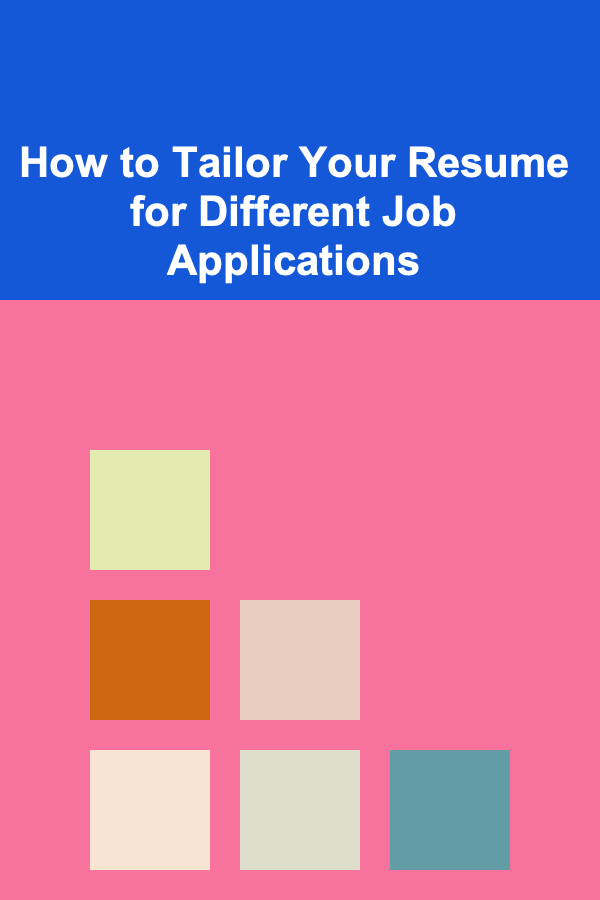
How to Tailor Your Resume for Different Job Applications
ebook include PDF & Audio bundle (Micro Guide)
$12.99$6.99
Limited Time Offer! Order within the next:

A well-crafted resume is your personal marketing tool. It should tell a compelling story about your skills, experience, and potential value to a prospective employer. However, sending out the same generic resume to every job application is unlikely to get you the results you want. Tailoring your resume for each job application is essential to stand out and show that you are the best fit for the role.
In this actionable guide, we will explore how to tailor your resume effectively for different job applications. We'll cover the key areas you need to focus on, including understanding job descriptions, adjusting your skills and experience, and structuring your resume to match different job requirements.
Understand the Job Description and Company
The first step in tailoring your resume is to thoroughly understand the job description and the company you're applying to. This is the foundation of your customization process.
Analyze the Job Description
A job description provides critical information about the employer's needs. Take time to break down each section of the description and identify key areas that you need to highlight on your resume:
- Key Responsibilities: Identify the core responsibilities of the role. What are the main tasks the employer expects you to perform?
- Required Skills: What specific technical, soft, or transferable skills are mentioned? These are the skills you should emphasize on your resume.
- Qualifications & Experience: Look for the education, certifications, or years of experience required. These elements should be clearly presented in your resume.
- Keywords: Many companies use Applicant Tracking Systems (ATS) to screen resumes. Make sure you include relevant keywords from the job description to improve your chances of passing through these systems.
Research the Company
Understanding the company's culture, mission, and values is just as important as understanding the job. The company's website, LinkedIn profile, and recent news articles can provide insights into its goals and culture. Use this knowledge to tailor your resume to align with the company's values.
- Company Values and Mission: If the company values innovation, diversity, or community, mention how your previous roles reflect these aspects.
- Industry Insights: Understand the challenges and trends in the industry the company operates in. This could inform the language and skills you use to highlight your fit for the company.
Tailor the Professional Summary
The professional summary is the first thing hiring managers see, so it's critical to tailor it to the specific role you're applying for. This brief, impactful section should showcase your unique selling points and key qualifications.
Customize Your Elevator Pitch
For each job application, write a professional summary that speaks directly to the role you're applying for. Focus on the following:
- Positioning Yourself: Highlight your experience and skills that are directly relevant to the job.
- Skills and Achievements: Include the most significant accomplishments that align with the job description. Be concise and quantify your impact whenever possible.
- Cultural Fit: If applicable, reference the company's values or mission to demonstrate that you are aligned with their culture.
For example, instead of a generic "Experienced marketing professional," tailor it to the role, such as "Results-driven marketing manager with over 5 years of experience in digital marketing, specializing in content strategy and data-driven campaigns, passionate about driving innovation in e-commerce."
Highlight Relevant Skills
One of the most crucial parts of tailoring your resume is aligning your skills with the job requirements. Companies look for candidates with specific skills, so you need to make it clear that you possess the expertise they're seeking.
Focus on Hard and Soft Skills
- Hard Skills: These are specific, teachable abilities, such as proficiency in software, coding languages, project management tools, or technical knowledge. Carefully match the hard skills listed in the job description with your experience and highlight them in your resume.
- Soft Skills: These include attributes like communication, teamwork, adaptability, and problem-solving. Tailor your soft skills to match the role's requirements and the company's culture. For example, if the job requires you to work in cross-functional teams, emphasize your collaboration skills.
Incorporate Keywords for ATS
Applicant Tracking Systems scan resumes for specific keywords that match the job description. These keywords are typically found in the skills section of the job listing. Use them strategically in your resume, particularly in the skills and experience sections. However, don't overstuff your resume with keywords -- ensure they are used naturally.
Adjust Your Work Experience
Your work experience section is where you will showcase your most relevant accomplishments. Rather than listing every job you've ever had, tailor this section to focus on positions and tasks that align with the job you're applying for.
Emphasize Relevant Roles and Responsibilities
Look at the job description and identify the core responsibilities. Then, adjust your work experience section to showcase tasks that are directly related to those responsibilities. For instance:
- If the job emphasizes managing teams, highlight leadership roles and team management experience.
- If the role is focused on customer service, emphasize your experience in handling customer inquiries and resolving issues.
Quantify Your Achievements
Whenever possible, quantify your accomplishments. Numbers provide context and show the impact of your work. For example:
- "Increased sales by 25% through targeted digital marketing campaigns."
- "Managed a team of 10 and improved project delivery time by 15%."
Quantified results help hiring managers understand the tangible benefits you can bring to their organization.
Tailor Education and Certifications
While your education and certifications may seem static, they can still be tailored for each job application. Depending on the role, certain educational backgrounds or certifications might be more relevant.
Highlight Relevant Degrees or Certifications
If the job requires specific degrees or certifications, make sure they are prominently displayed in your resume. For example, if the job requires a Project Management Professional (PMP) certification, place it in a highlighted section of your resume.
- If you have a degree in a field that's particularly relevant to the job (such as a degree in Computer Science for a tech role), emphasize it early in the education section.
- If the job calls for a specialized skill (like knowledge of a specific software), and you have a certification in that tool, list it clearly.
Remove Irrelevant Information
On the other hand, if your education or certifications are not directly relevant to the job, you can leave them off or simply list them with fewer details.
Tailor Your Resume's Layout and Design
The layout of your resume should also be tailored to fit the type of job you're applying for. Certain industries have expectations for resume formats, so make sure your layout aligns with what's commonly accepted in your field.
Consider Industry Standards
For creative industries, such as graphic design, marketing, or entertainment, you might want to have a more visually appealing resume that showcases your creativity. For more traditional industries, like law or finance, stick to a clean and professional design.
- Design for Readability: Regardless of industry, your resume should be easy to read. Use bullet points, headers, and consistent formatting to guide the reader through the document.
- Tailor Sections Based on Role: For some roles, you may want to focus more on a specific section. For example, for technical roles, emphasize technical skills and certifications over a lengthy professional summary.
Add a Personal Touch with a Cover Letter
While not part of the resume itself, the cover letter is an important part of tailoring your application. In the cover letter, you can further explain why you are a great fit for the role and demonstrate that you've done your research on the company.
Customize the Cover Letter for Each Job
Just like your resume, your cover letter should be customized for each job application. Address the hiring manager by name, if possible, and explain how your skills, experience, and values align with the job and the company. This is where you can demonstrate your enthusiasm for the role and the organization.
Conclusion
Tailoring your resume for different job applications is not just about tweaking a few sections here and there. It's about strategically highlighting the skills, experiences, and achievements that are most relevant to the job you're applying for. By thoroughly analyzing job descriptions, adjusting your professional summary, focusing on key skills, and emphasizing your most relevant experience, you significantly increase your chances of catching the attention of hiring managers.
Remember, each job application is a new opportunity to make a strong first impression. Customizing your resume shows that you've done the work, understand the company's needs, and are genuinely interested in the position. It's an investment that pays off by bringing you closer to your ideal job.
Reading More From Our Other Websites
- [Survival Kit 101] Survival Kit vs Bug Out Bag: Which One Should You Choose for Emergencies?
- [Home Budget Decorating 101] How to Master Budget-Friendly Ways to Hide Wires for a Clutter-Free Space
- [Organization Tip 101] How to Set Up a Sleepover Kit for Friends
- [Home Pet Care 101] How to Identify and Manage Common Pet Behavioral Issues
- [Personal Care Tips 101] How to Use Deodorant to Prevent Body Odor During Stressful Situations
- [Home Family Activity 101] How to Set Up a Family Gardening Project in Your Backyard
- [Home Staging 101] How to Stage Your Home When You Have Pets
- [Personal Care Tips 101] How to Use Shampoo for Dandruff Treatment
- [Home Security 101] How to Safeguard Your Home from Seasonal Security Risks
- [Paragliding Tip 101] Thermal Hunting: How to Find and Use Updrafts in Paragliding

How to Plan a Cocktail Party with a Classy Touch
Read More
How to Prepare for Space Emergencies
Read More
How to Update Your Lighting Fixtures Without Spending a Lot
Read More
The Step-by-Step Guide to Enhancing Memory
Read More
How to Plan a Pet First-Aid Kit for Emergencies
Read More
How to Create a Wedding Planning Checklist for a Tight Budget
Read MoreOther Products

How to Plan a Cocktail Party with a Classy Touch
Read More
How to Prepare for Space Emergencies
Read More
How to Update Your Lighting Fixtures Without Spending a Lot
Read More
The Step-by-Step Guide to Enhancing Memory
Read More
How to Plan a Pet First-Aid Kit for Emergencies
Read More